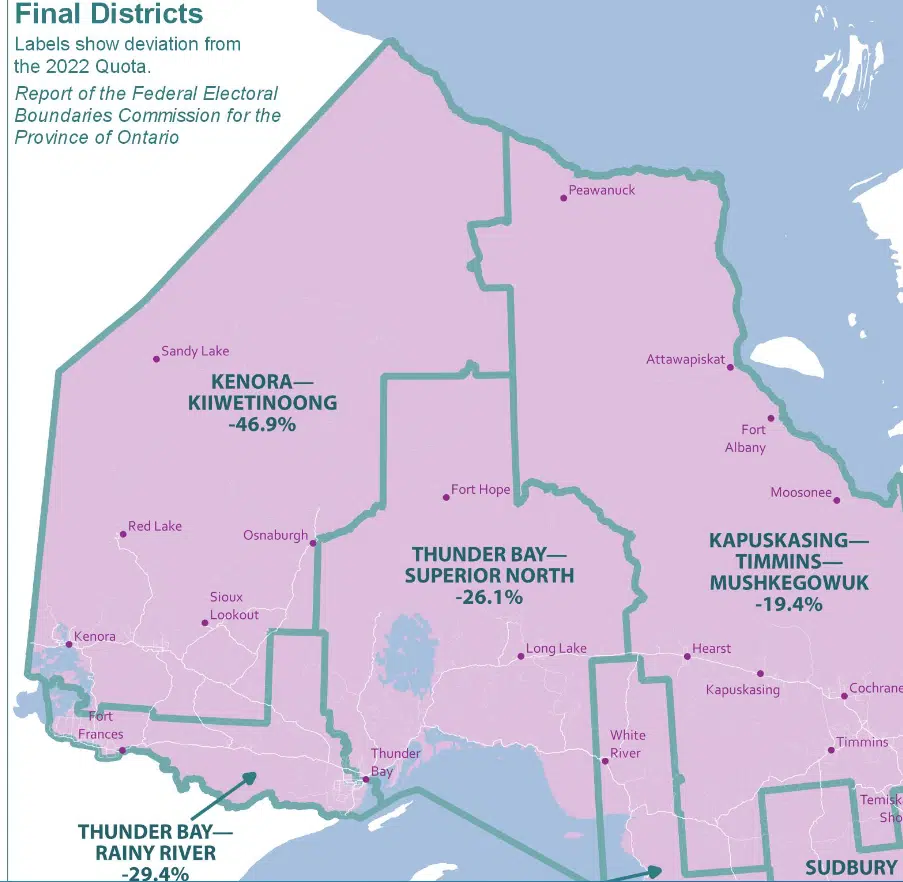
File Photo
There were several concerns made by the public over a proposal from the Federal Electoral Boundaries Commission that would have seen one fewer riding in Northern Ontario, however in its report issued to the House of Commons, and released to the public Friday, the panel has backed down on that, along with several other elements.
This comes after months of work which included public consultations in several communities here in Northwestern Ontario.
One piece that raised some controversy here in the Northwest involved the more urban areas of the Kenora riding, such as both the City of Kenora and Dryden, and the smaller rural communities of Machin and Ignace be absorbed into the Thunder Bay – Rainy River riding.
While the northern portion which includes the municipalities of Sioux Lookout and Red Lake along with dozens of small First Nation communities join with a northeastern Ontario riding to stretch from the Manitoba border to the Quebec border.
That possibility led to many municipal councils passing resolutions in opposition to the proposal, in addition to other political representatives, organizations and members of the general public.
In addition to the outcry from the public which feared a loss of representation in the rural areas, the commission also acknowledged its lack of observation of the tribal council lines, which if the proposal had been implemented, would have separated the northern and southern halves of Grand Council Treaty Three Territory.
The report also acknowledged issues relating to travel such as creating a riding that would require elected officials to travel more than 1,000 kilometres on highways, round trip, to meet with constituents. It also touched on the requirement for air travel in the north, which is both costly and limited.
Flights to the Northwest must go through Thunder Bay and Sioux Lookout, flights to the Northeast must go through Timmins, and Thunder Bay and
Timmins are a day’s drive apart with no direct flights connecting them. – Report of the Federal Electoral Boundaries Commission for the Province of
Ontario
Concerns addressed in the report also accept it being impossible to create a district with a majority Indigenous population, the two large northern ridings do have significant northern Indigenous populations, ensuring Indigenous interests are not overlooked and creates the opportunity for the election of Indigenous candidates.
From a matter of changes recommended in the report, nothing will happen to Thunder Bay – Rainy River, but there is a proposed renaming of the Kenora riding to Kenora – Kiiwetinoong and Thunder Bay Superior North will grow a little bit to include all communities of the Matawa First Nations Management Tribal Council.
All three ridings have also been given a special designation which will allow them to have population totals below established riding quotas according to the report.
However, only in the three northwestern districts – KENORA—KIIWETINOONG (population 61,962), THUNDER BAY—SUPERIOR NORTH (population 86,147), and THUNDER BAY—RAINY RIVER (population 82,357) – have we identified “extraordinary circumstances” to justify such deviations. – Report of the Federal Electoral Boundaries Commission for the Province of Ontario
The report also states the mismatch in population growth between Northern Ontario, at 2.8% and the rest of the province, 11.2% could lead to issues in the future, as if 10 districts are maintained in Northern Ontario, like is in the current proposal, the average district population would be 85,513 people or 73% of the quota.
As a result the “likely requirement of legislative action” to halt the further decline of the number of seats in the North will need to be addressed.
The next step in the process will include Objections from MPs, which will take place from now until May, then the consideration of those objections from the Commission, between May and June, before the Representation Order in September.




